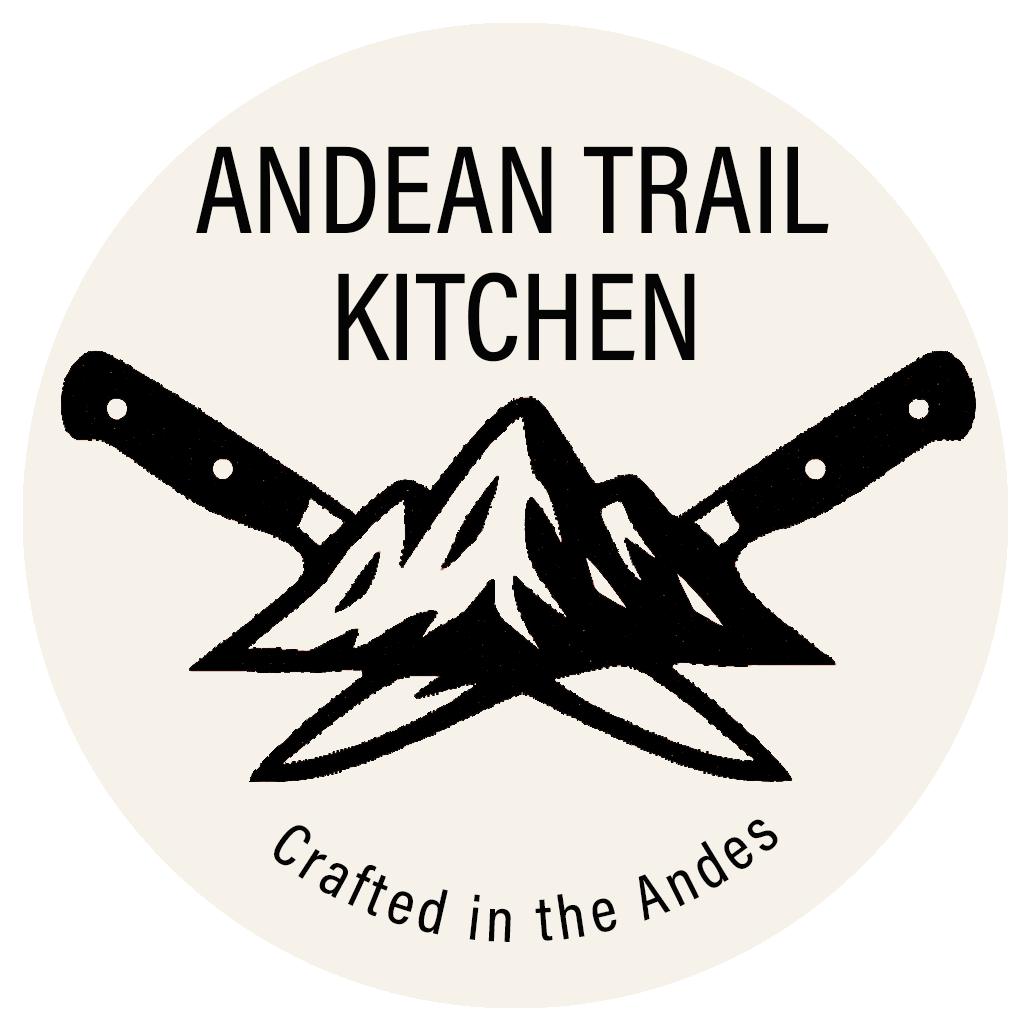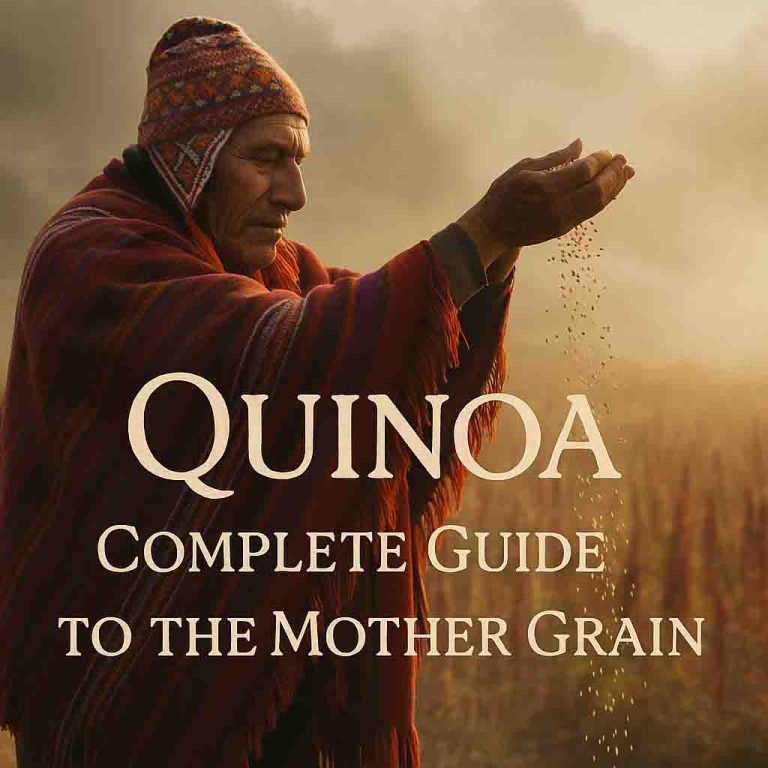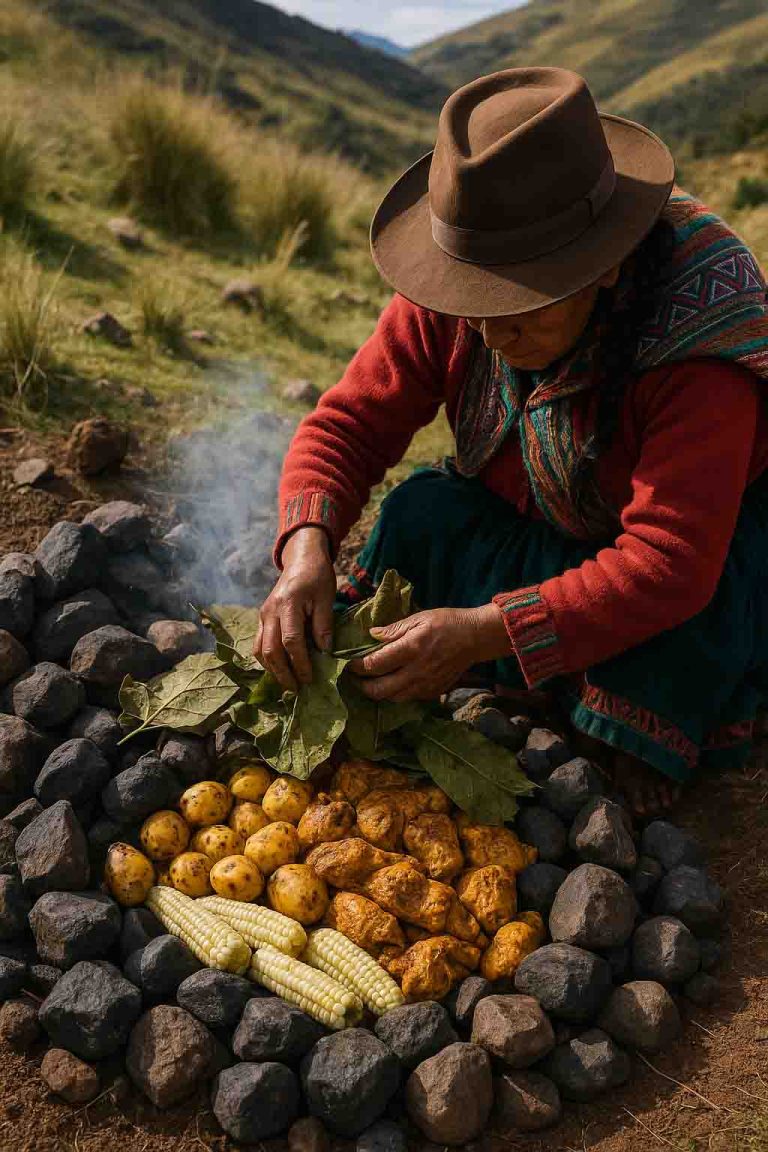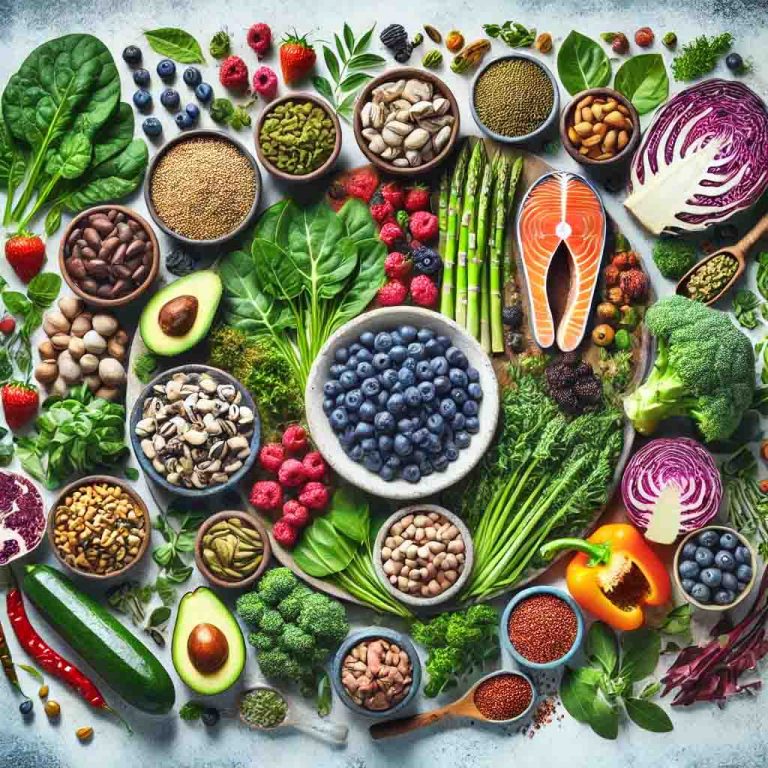Complete Guide to Andean Superfoods (2025)
Introduction: Ancient Foods for Modern Vitality
Nestled among the towering peaks of the Andes Mountains lies one of the world’s most remarkable agricultural treasures. Here, where the air is thin and the conditions are harsh, an extraordinary biodiversity has flourished for millennia—one that has nourished civilizations and shaped cultures through countless generations.
“The Andes region isn’t just a place of extraordinary beauty, but a living laboratory of agricultural resilience, producing foods with nutritional profiles unmatched anywhere else on earth.” — Dr. Eduardo Ramírez, Agricultural Anthropologist, University of Cusco
The Andes region is home to over 4,000 varieties of potatoes alone, a staggering testament to the agricultural ingenuity of its people. But beyond potatoes, this vast mountain range has gifted the world with an array of exceptionally nutrient-dense foods that are increasingly recognized for their remarkable health benefits.
These Andean superfoods—from protein-rich quinoa and amaranth to adaptogenic maca and antioxidant-packed berries—represent not just nutritional powerhouses but living cultural heritage. Cultivated through ancient farming practices and prepared according to wisdom passed down through generations, these foods offer modern eaters a bridge between traditional knowledge and contemporary wellness.
In this comprehensive guide, we’ll journey through the vibrant world of Andean superfoods. You’ll discover:
- What truly makes these foods “super” and how their growing conditions contribute to their exceptional nutritional profiles
- Detailed profiles of 10 essential Andean superfoods with their traditional uses and modern applications
- Practical ways to incorporate these foods into your daily meals, from beginner-friendly recipes to advanced culinary techniques
- How these foods support specific health goals from improved digestion to enhanced energy and immune function
- Ethical sourcing considerations to ensure your food choices support both sustainable practices and indigenous communities
Whether you’re a nutrition enthusiast, a curious cook, or someone seeking to diversify your diet with some of the world’s most nutritionally dense foods, this guide will serve as your roadmap to the remarkable world of Andean superfoods.
For practical meal planning using these superfoods, check out our companion guide: 7-Day Andean Superfood Meal Plan
What Makes a Food “Super”?
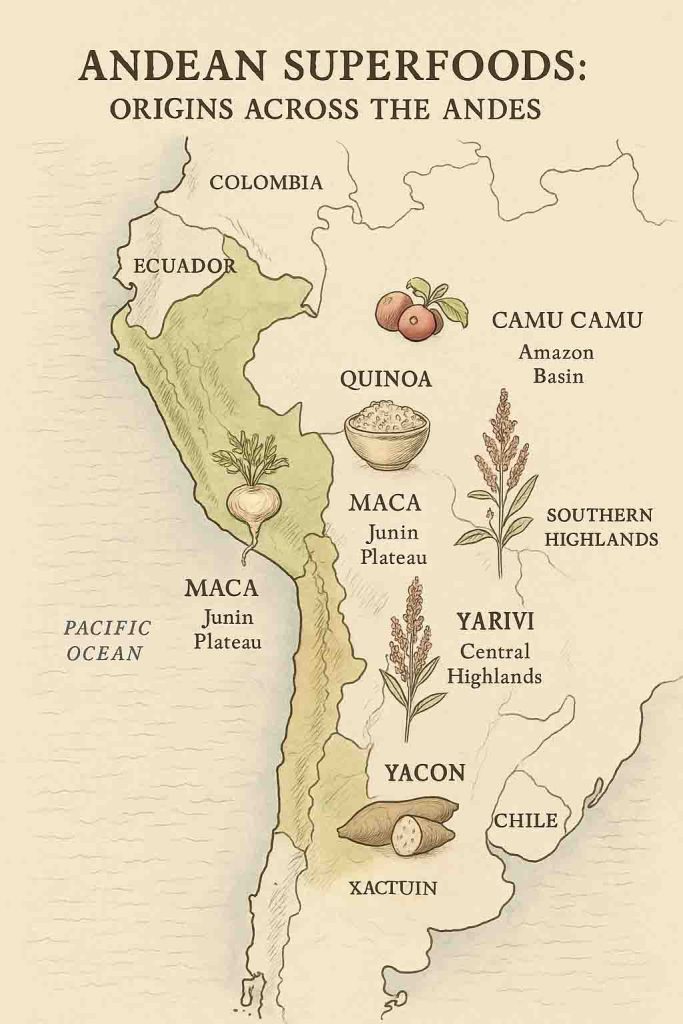
Beyond the Buzzword: Defining Superfoods
The term “superfood” has become increasingly common in our health-conscious world, but what exactly qualifies a food for this distinguished status? While no single definition exists in nutritional science, superfoods are generally recognized as natural foods with exceptionally high concentrations of nutrients, bioactive compounds, and health-promoting properties relative to their caloric content.
Dr. Elena Vasquez, nutritional anthropologist specializing in indigenous food systems, explains: “True superfoods offer nutritional profiles that are remarkably dense and diverse. What makes Andean superfoods particularly special is not just their nutrient content, but how these nutrients exist in balanced combinations that traditional communities have optimized through centuries of agricultural practice.”
Genuine superfoods typically feature:
- Exceptional micronutrient density (vitamins and minerals)
- High levels of antioxidants that combat cellular damage
- Significant fiber content supporting digestive health
- Beneficial plant compounds with bioactive properties
- Complete protein profiles (in some cases)
- Low levels of anti-nutrients that might impair absorption
The Andean Advantage: How Geography Creates Nutritional Powerhouses
The unique geography of the Andes creates growing conditions unlike anywhere else on Earth, directly contributing to the exceptional nutritional profiles of foods grown there:
Altitude Effects
Growing at elevations between 2,500 and 4,200 meters (8,200-13,800 feet), Andean crops develop under intense ultraviolet radiation. This environmental stress triggers the production of protective compounds—polyphenols, flavonoids, and other antioxidants—that benefit human health when consumed.
Soil Composition
Volcanic soils in many Andean growing regions provide mineral-rich growing mediums not found in conventional agriculture. These minerals are incorporated into the plant tissues, creating foods with exceptional mineral profiles.
Temperature Fluctuations
The dramatic daily temperature variations in the high Andes (warm days and freezing nights) create stress conditions that force plants to develop resilience mechanisms, many of which translate to nutritional benefits.
Low-Input Agriculture
Many traditional Andean farming practices rely on minimal external inputs, instead focusing on companion planting, natural pest management, and working with natural cycles—resulting in foods with more complex nutritional profiles than those grown with conventional methods.
Discover how these traditional growing methods align with seasonal cycles in our Seasonal Guide to Andean Superfoods
Comparing Nutritional Density: Andean Foods vs. Common Alternatives
NutrientQuinoa (1 cup)White Rice (1 cup)Amaranth (1 cup)Wheat (1 cup)Protein8.1g4.3g9.3g6.0gFiber5.2g0.6g5.2g3.9gIron2.8mg0.3mg5.2mg1.1mgMagnesium118mg19mg160mg26mgZinc2.0mg0.8mg2.9mg0.9mgComplete ProteinYesNoYesNo
Note: Values are approximations; actual nutritional content may vary based on growing conditions, preparation methods, and variety.
The Cultural Context: Beyond Nutrition
What truly sets Andean superfoods apart is not just their nutritional content, but their cultural significance. These are not simply ingredients; they are the foundation of resilient food systems that have sustained civilizations through climate fluctuations, political upheavals, and cultural transformations over thousands of years.
Dr. Carlos Menendez, food historian at the University of Cusco, notes: “When we speak of Andean superfoods, we’re discussing living cultural heritage. These are not static products but dynamic elements of food systems that continue to evolve. The wisdom in how these foods are traditionally grown, prepared, and combined represents knowledge as valuable as their nutritional profiles.”
For deeper insights into the cultural significance of these foods, explore our article on Sacred Foods: The Spiritual Significance of Andean Superfoods
The Essential Andean Superfoods Guide
1. Quinoa: The Mother Grain
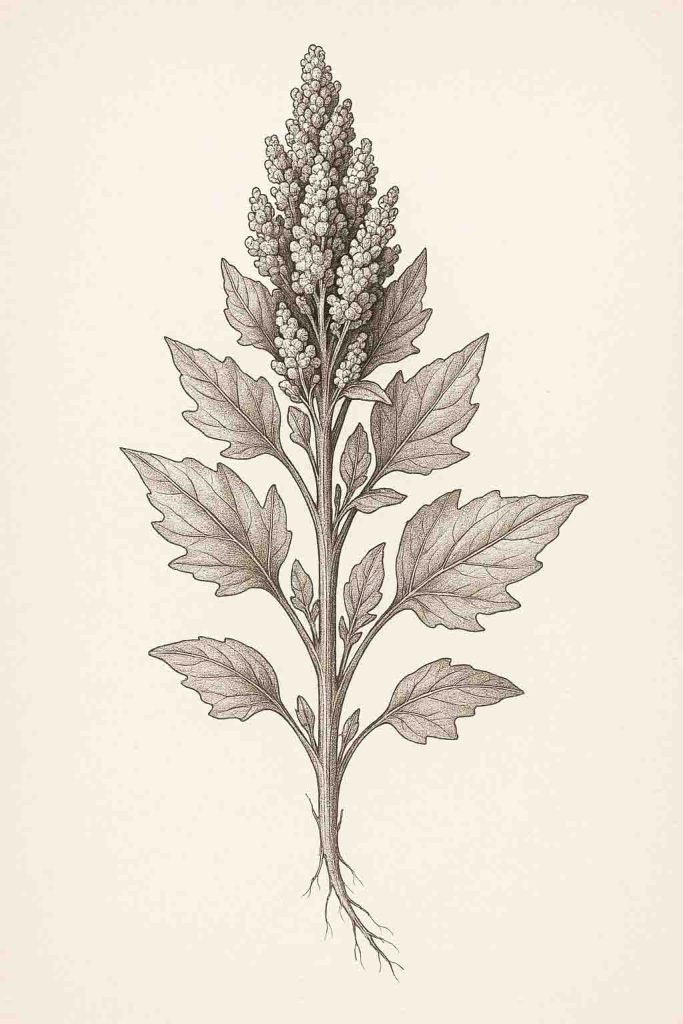
Discover everything about this versatile ancient grain in our comprehensive guide: Quinoa: Complete Guide to the Mother Grain
The Sacred Seed of the Andes
Revered as “chisaya mama” or “mother grain” by the Incas, quinoa (pronounced KEEN-wah) has sustained Andean populations for over 5,000 years. Technically not a grain but a seed, quinoa was so central to Andean civilization that it was considered sacred, with the Incan emperor traditionally sowing the first seeds of each season.
Nutritional Profile: A Complete Protein Powerhouse
Quinoa stands apart from most plant foods as a complete protein source, containing all nine essential amino acids the human body cannot produce on its own. This exceptional nutritional profile includes:
- Protein: 8-9g per cooked cup, with a balanced amino acid profile similar to milk
- Fiber: 5g per cup, supporting digestive health and sustained energy
- Minerals: Rich in manganese, magnesium, phosphorus, folate, and iron
- Antioxidants: Contains quercetin and kaempferol, powerful plant compounds with anti-inflammatory properties
- Low glycemic index: Helps maintain steady blood sugar levels
Beyond White: The Rainbow of Quinoa Varieties
While white quinoa is most commonly found in stores worldwide, this superfood comes in over 3,000 varieties, each with subtle differences in flavor, texture, and nutrient composition:
- White/Ivory Quinoa: Mildest flavor, cooks the quickest, and becomes fluffy
- Red Quinoa: Maintains its shape better after cooking, with a nuttier flavor and slightly higher antioxidant content
- Black Quinoa: Earthiest flavor, takes longest to cook, with the highest anthocyanin content (antioxidants)
- Multicolored/Rainbow Quinoa: A mix of varieties offering varied nutrients and textures
From Field to Table: Traditional Preparation
Traditional quinoa preparation in the Andes involves several important steps that modern cooks sometimes overlook:
- Saponin Removal: Quinoa seeds are naturally coated with saponins, bitter compounds that protect the plant from predators. Traditional processing involves rubbing the seeds against rough stones in running water to remove this coating.
- Toasting: Many traditional recipes begin by lightly toasting quinoa before cooking, which enhances its nutty flavor and reduces cooking time.
- Culinary Applications: In its native regions, quinoa appears in countless forms—from breakfast porridges (pesqhe) to fermented beverages (chicha) to hearty stews with vegetables and herbs.
Learn about traditional preparation methods in our Andean Cooking Methods: A Complete Guide
Modern Kitchen Basics: Preparing Perfect Quinoa
For optimal texture and flavor in your home kitchen:
- Rinse thoroughly: Even pre-washed quinoa benefits from rinsing under cold water until the water runs clear.
- Perfect ratio: Use 1 part quinoa to 2 parts liquid for fluffy results.
- Cooking method: Bring to a boil, then reduce to a simmer, cover, and cook for about 15 minutes until the liquid is absorbed and the germ (a small white spiral) becomes visible.
- Resting period: Let stand, covered, for 5-10 minutes after cooking, then fluff with a fork.
Having trouble with preparation? See our Troubleshooting Guide: Common Mistakes with Andean Superfoods
Recipe Feature: Morning Vitality Quinoa Bowl
Serves 2 | Preparation time: 5 minutes | Cooking time: 20 minutes
Ingredients:
- 1 cup rainbow quinoa, rinsed
- 2 cups water or plant-based milk
- 1 cinnamon stick
- 1 star anise pod
- 1 tablespoon maple syrup or lucuma powder
- Fresh seasonal berries
- Sliced banana
- 2 tablespoons toasted Andean seeds (pumpkin, sunflower, chia)
- Fresh mint leaves
Preparation:
- Combine quinoa, liquid, cinnamon stick, and star anise in a saucepan.
- Bring to a boil, then reduce heat and simmer covered for 15 minutes until liquid is absorbed.
- Remove from heat, discard spices, and let stand covered for 5 minutes.
- Fluff with a fork and divide between two bowls.
- Top with fresh fruit, seeds, a drizzle of sweetener, and mint leaves.
Nutrition tip: This balanced breakfast provides sustained energy through complex carbohydrates, complete protein, and healthy fats.
Find more family-friendly recipe ideas in Andean Superfoods for Families
Sustainability Considerations
The global quinoa boom has brought both opportunities and challenges to Andean producers. While increased demand has raised incomes for many farming families, it has also led to concerns about local food security and soil health in some regions.
To support sustainable quinoa production:
- Look for Fair Trade certified quinoa
- Seek out brands that work directly with producer cooperatives
- Consider supporting diverse Andean crops beyond quinoa
Learn more about ethical sourcing and the environmental impact in: From Field to Table: The Journey of Andean Superfoods
2. Maca: Andean Energy Root
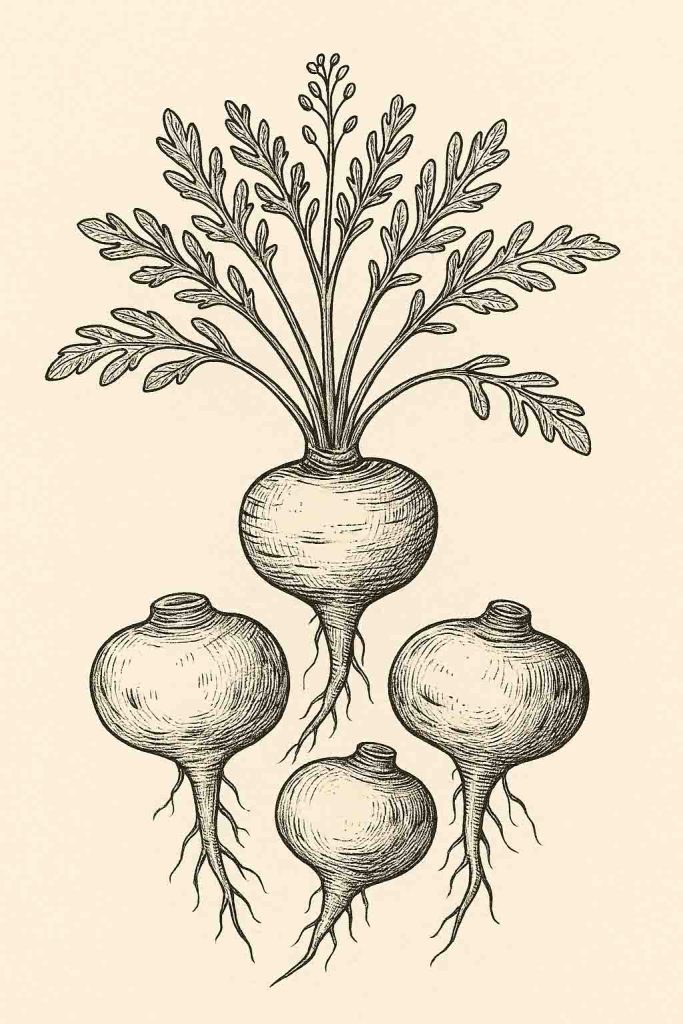
For a deeper exploration of this powerful adaptogen, see our detailed guide: Maca Root: Ancient Energizer for Modern Life
The High-Altitude Adaptogen
Thriving at elevations of up to 15,000 feet (4,500 meters), maca (Lepidium meyenii) grows where few other food plants can survive. This resilient root vegetable has been cultivated in the central Andes of Peru for at least 2,000 years, particularly around Lake Junín where extreme temperature fluctuations and intense sunlight create the perfect conditions for its growth.
Nutritional Profile: Nature’s Energizer
Maca’s reputation as an energy enhancer is supported by its impressive nutrient density:
- Macronutrients: Provides carbohydrates, protein (with 18 amino acids including all essentials), and a small amount of healthy fats
- Vitamins: Rich in vitamin C, several B vitamins including B6, and niacin
- Minerals: Contains calcium, potassium, iron, iodine, copper, and manganese
- Bioactive compounds: Features unique glucosinolates and macamides thought to contribute to its adaptogenic properties
- Alkaloids: Contains macaridine, a compound unique to maca
Traditional Uses: From Warfare to Fertility
In traditional Andean culture, maca served multiple important functions:
- Warrior preparation: Incan warriors reportedly consumed maca before battle for strength and endurance
- Fertility support: Traditionally used to enhance reproductive health in both humans and livestock
- Altitude adaptation: Used to help the body adapt to the harsh conditions of high-altitude living
- Nutritional staple: During times of scarcity, maca provided critical nutrients when other crops failed
Explore how these traditional uses align with modern health goals in Andean Superfoods for Specific Health Goals
The Rainbow of Maca: Understanding Different Varieties
Maca comes in several color varieties, each associated with somewhat different properties in traditional use:
- Yellow/Cream Maca: Most common (60-70% of production), traditionally used for energy and nutrition
- Red Maca: Comprising about 25% of production, traditionally associated with female reproductive health
- Black Maca: The rarest form (10-15% of production), traditionally linked to male vitality and cognitive function
Modern Forms and Applications
Today’s consumer can find maca in several convenient forms:
- Powder: The most versatile form, easily added to smoothies, oatmeal, or baked goods
- Capsules: Convenient for consistent dosing without the distinctive flavor
- Liquid extracts: Fast-absorbing tinctures for maximum bioavailability
- Gelatinized maca: Pre-cooked for easier digestion and nutrient absorption
Balancing Maca’s Distinctive Flavor
Maca’s flavor profile is unique—earthy with notes of butterscotch and a hint of radish-like pungency. This distinctive taste can be balanced by:
- Pairing with sweet flavors like banana, cacao, or cinnamon
- Starting with small amounts (1/2 teaspoon) and gradually increasing
- Using in recipes with strong complementary flavors
- Choosing gelatinized maca for a milder taste profile
Need help incorporating maca into your meals? Check out our Andean Superfood Substitution Guide for creative uses
The Science Behind the Tradition
Modern research has begun to validate many traditional uses of maca:
- Energy and stamina: Studies suggest improvements in physical endurance and reduction in fatigue
- Hormonal balance: Research indicates positive effects on perimenopausal symptoms in women
- Mood enhancement: Several studies note improvements in anxiety and depression scores
- Male reproductive health: Research shows potential benefits for sperm quality and quantity
Recipe Feature: Energizing Maca Morning Elixir
Serves 1 | Preparation time: 5 minutes
Ingredients:
- 1 cup plant-based milk (almond, oat, or quinoa milk work well)
- 1 tablespoon maca powder (start with 1 teaspoon if new to maca)
- 1 frozen banana
- 1 tablespoon almond or cashew butter
- 1/2 teaspoon cinnamon
- 1/4 teaspoon vanilla extract
- Pinch of sea salt
- 1 teaspoon honey or maple syrup (optional)
- Ice cubes (optional)
Preparation:
- Combine all ingredients in a high-speed blender.
- Blend until smooth and creamy.
- Pour into a glass and enjoy immediately for maximum nutritional benefits.
Usage tip: This energizing beverage makes an excellent pre-workout drink or morning alternative to coffee.
Find more energy-boosting recipes in our guide for Andean Superfoods for Plant-Based Athletes
Mindful Consumption: When and How to Use Maca
For optimal results and to honor traditional wisdom around this powerful root:
- Start small: Begin with 1/2-1 teaspoon daily and gradually increase
- Consistency matters: Maca works best when consumed regularly over time
- Cycling is traditional: Indigenous use often involves periods of consumption followed by breaks
- Timing considerations: Morning consumption may be best for those sensitive to stimulants
Sourcing and Sustainability
True maca can only be grown in the specific conditions of the high Andes. As global demand increases, concerns about sustainable production have emerged. Look for:
- Direct trade relationships with Peruvian producers
- Organic certification to ensure sustainable growing practices
- Transparent sourcing information from brands
- Fair pricing that reflects the intensive labor required for cultivation
For guidance on building your superfood pantry, visit: Andean Superfood Pantry: Complete Setup Guide
3. Amaranth: The Incan Protein Powerhouse

Learn more about this resilient ancient grain in our guide: Amaranth: The Forgotten Protein Powerhouse
A Grain That Survived Conquest
Amaranth holds a unique place in Andean history as a crop that nearly disappeared during Spanish colonization. Sacred to the Incas and used in religious ceremonies, amaranth cultivation was banned by conquistadors who recognized its cultural significance. Despite these efforts to eradicate it, amaranth survived in remote mountainous areas, preserved by indigenous farmers who recognized its exceptional nutritional value.
Nutritional Profile: Protein and Lysine Rich
Amaranth’s nutritional profile makes it exceptional among plant foods:
- Protein: Contains 9g per cup (cooked), with a superior amino acid balance
- Lysine: Particularly high in this essential amino acid often lacking in other grains
- Minerals: Exceptional source of manganese, magnesium, phosphorus, and iron
- Fiber: Contains both soluble and insoluble fiber for digestive health
- Squalene: Contains this rare antioxidant compound also found in olive oil
- Gluten-free: Naturally free of gluten and suitable for those with celiac disease
Traditional Uses: From Popped Grains to Sacred Drinks
In traditional Andean culture, amaranth appeared in various forms:
- Tanta wawa: Ceremonial bread figures made with amaranth flour
- Kiwicha: Popped amaranth mixed with honey or molasses to form sweet treats
- Atole: A warm, thick beverage made with ground amaranth
- Leaf vegetables: Young leaves consumed as nutritious greens
Modern Kitchen Applications
Today’s cooks can incorporate amaranth in multiple ways:
- Cooked grain: Simmered like rice (1:3 ratio with water) for a porridge-like consistency
- Popped: Quickly heated in a dry pan until it pops like miniature popcorn
- Flour: Ground amaranth can replace up to 25% of wheat flour in baking
- Sprouted: Germinated for a nutrient-dense addition to salads
- Microgreens: Grown for tender, nutritious young shoots
Need help troubleshooting your amaranth preparation? See our Troubleshooting Guide: Common Mistakes with Andean Superfoods
Recipe Feature: Amaranth and Fruit Morning Porridge
Serves 2 | Preparation time: 5 minutes | Cooking time: 25 minutes
Ingredients:
- 1 cup amaranth grain
- 3 cups water
- 1/4 teaspoon sea salt
- 1/2 teaspoon cinnamon
- 1 tablespoon honey or maple syrup
- 1/2 cup mixed seasonal berries
- 2 tablespoons toasted almonds or pepitas
- Fresh mint leaves for garnish
Preparation:
- Rinse amaranth in cold water using a fine-mesh strainer.
- Combine amaranth, water, and salt in a medium saucepan.
- Bring to a boil, then reduce heat to low and simmer, partially covered, for 20-25 minutes, stirring occasionally until water is absorbed.
- Stir in cinnamon and sweetener.
- Divide between two bowls and top with berries, nuts, and mint.
Serving suggestion: This porridge makes an excellent breakfast but can also serve as a nutritious dessert when made with extra cinnamon and fruit.
For more family-friendly recipe ideas, check out our guide to Andean Superfoods for Families
Sustainability and Cultural Revitalization
Amaranth represents not just a nutritional powerhouse but a cultural revival story. Its renewed popularity has helped indigenous farming communities reclaim traditional knowledge and create economic opportunities.
Supporting sustainable amaranth production involves:
- Seeking out heirloom varieties that support genetic diversity
- Looking for brands that partner directly with indigenous producers
- Understanding the cultural context of this important crop
Discover the broader cultural significance in our article on Sacred Foods: The Spiritual Significance of Andean Superfoods
[Content for remaining 7 superfoods continues…]
Health Benefits of Andean Superfoods
The Science Behind Superfood Benefits
The exceptional health benefits of Andean superfoods aren’t just traditional claims—modern research increasingly validates the wisdom of ancient food systems. While no single food can provide complete nutrition or be a magic bullet for health concerns, the unique properties of these foods make them valuable additions to a balanced diet.
For detailed research on specific health applications, see our guide to Andean Superfoods for Specific Health Goals
Nutritional Density and Complete Nutrition
Andean superfoods offer exceptional nutritional density, with several noteworthy characteristics:
Complete Protein Sources
Several Andean plants provide complete protein profiles containing all nine essential amino acids—a rarity in the plant kingdom:
- Quinoa: Contains a balanced amino acid profile similar to milk
- Amaranth: Particularly high in lysine, often lacking in cereal grains
- Tarwi: Contains up to 50% protein by dry weight
- Kañiwa: Complete protein with higher iron content than quinoa
Micronutrient Excellence
Rich in vitamins and minerals that support overall health:
- Iron: Critical for oxygen transport and energy production, abundant in kañiwa and amaranth
- Magnesium: Essential for over 300 biochemical reactions, found in quinoa and amaranth
- Vitamin C: Powerful immune support from camu camu, oca, and yacón
- Zinc: Important for immune function and wound healing, present in quinoa and tarwi
- Potassium: Key electrolyte for heart and muscle function, found in yacón and oca
Fiber and Digestive Health
Andean superfoods offer diverse fiber types that support gut health:
- Resistant starch: Found in tubers like oca and mashua, feeds beneficial gut bacteria
- Soluble fiber: Present in quinoa and amaranth, helps manage cholesterol levels
- Insoluble fiber: Abundant in many Andean grains, supports regular elimination
- Prebiotic fiber: Especially high in yacón, feeding probiotic organisms
Learn about combinations for optimal nutrition in our 7-Day Andean Superfood Meal Plan
Supporting Specific Health Goals
Cardiovascular Health
Multiple Andean superfoods contribute to heart health through:
- Healthy fats: Tarwi and quinoa provide omega-3 and omega-6 fatty acids
- Fiber content: Helps manage cholesterol levels
- Potassium balance: Supports healthy blood pressure
- Antioxidant protection: Reduces inflammation and oxidative stress
- Plant proteins: Lower in saturated fat than many animal proteins
Immune System Support
The immune-enhancing properties of Andean superfoods include:
- Vitamin C abundance: Exceptional levels in camu camu
- Zinc content: Critical for immune cell function
- Antioxidant protection: Counters free radical damage
- Antimicrobial compounds: Present in mashua and other traditional foods
- Gut microbiome support: Prebiotic fibers in yacón and tubers
Blood Sugar Management
Many Andean superfoods help maintain healthy blood sugar levels:
- Low glycemic impact: Slow-digesting complex carbohydrates
- Fiber content: Slows absorption of sugars
- Protein balance: Supports stable energy levels
- Natural sweeteners: Lucuma and yacón provide sweetness with less glycemic impact
- Micronutrients: Support proper insulin function
Find detailed guidance for specific conditions in our Andean Superfoods for Specific Health Goals guide
Traditional Wisdom Meets Modern Research
Traditional Andean food wisdom often predates scientific understanding by centuries, but modern research is now validating many traditional practices:
- Food combinations: Traditional pairings often maximize nutrient absorption
- Preparation methods: Traditional processing techniques reduce anti-nutrients
- Seasonal consumption: Aligns with the body’s changing needs throughout the year
- Whole food approach: Uses all parts of plants for complete nutrition
- Adaptogenic properties: Many Andean plants help the body adapt to stress
Explore the cultural context of these traditions in our Sacred Foods: The Spiritual Significance of Andean Superfoods article
Incorporating Andean Superfoods into Your Modern Kitchen
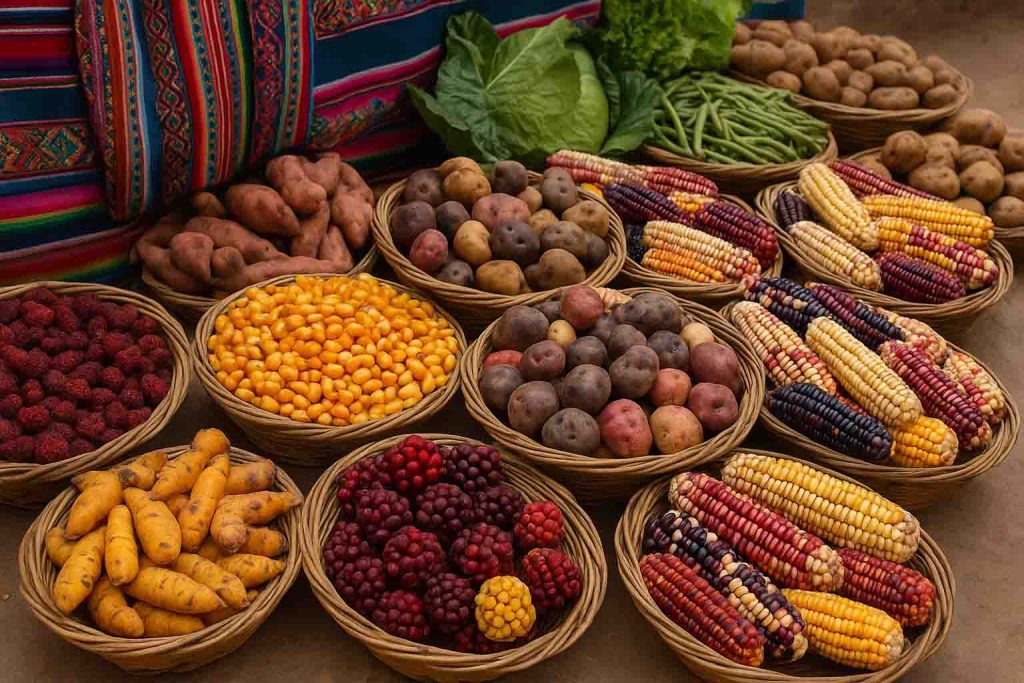
Building Your Andean Pantry
Creating a well-stocked Andean pantry allows you to easily incorporate these nutritional powerhouses into your daily meals. Here’s how to get started:
Essential Staples: Your Foundation
Begin with these versatile basics that can form the foundation of countless meals:
- Quinoa: White, red, and black varieties for different applications
- Amaranth: Both as whole grain and puffed for different textures
- Chia seeds: Though not exclusively Andean, they pair beautifully with Andean foods
- Maca powder: Start with a small amount to determine your preference
- Lucuma powder: Natural sweetener for various applications
For a complete shopping list and detailed storage information, see our Andean Superfood Pantry: Complete Setup Guide
Secondary Additions: Expanding Your Options
Once you’re comfortable with the basics, explore these additional ingredients:
- Kañiwa: Smaller cousin of quinoa with no bitter saponins
- Camu camu powder: Powerful vitamin C boost for smoothies and beverages
- Yacón syrup: Natural sweetener with prebiotic benefits
- Tarwi beans: If you can find them pre-prepared (debittered)
- Purple corn: Used in traditional beverages and for natural food coloring
Storage Solutions for Optimal Freshness
Proper storage extends shelf life and preserves nutritional quality:
- Airtight containers: Essential for all powders and grains
- Cool, dark storage: Protects oils in seeds and grains from rancidity
- Refrigeration considerations: Some items like maca and camu camu powder benefit from refrigeration after opening
- Vacuum sealing: Consider for longer-term storage of larger quantities
- Bulk purchasing: Economical but divide into smaller portions for daily use
Find more detailed guidance in our Andean Superfood Pantry: Complete Setup Guide
Simple Ways to Incorporate Andean Superfoods Daily
Adding these nutritional powerhouses to your diet doesn’t require a complete menu overhaul. Start with these simple approaches:
Breakfast Transformations
Morning meals offer perfect opportunities to incorporate Andean superfoods:
- Quinoa breakfast bowls: Cook with milk or plant milk and top with fruit
- Smoothie additions: Add 1-2 teaspoons of maca or lucuma to morning blends
- Overnight amaranth: Prepare like overnight oats with your favorite fruits
- Breakfast topping: Sprinkle puffed amaranth or quinoa on yogurt or cereal
- Morning elixirs: Add camu camu to morning beverages for vitamin C
Lunch and Dinner Integrations
Incorporate Andean ingredients into midday and evening meals:
- Grain bowl bases: Use quinoa or kañiwa as the foundation for lunch bowls
- Salad boosters: Add cooked and cooled quinoa or amaranth to salads
- Side dish swaps: Replace rice or couscous with Andean grains
- Soup thickeners: Add amaranth to soups for creamy texture
- Burger enhancements: Incorporate cooked quinoa or amaranth into plant-based patties
Snack and Treat Ideas
Satisfy between-meal hunger with nutrient-dense options:
- Energy bites: Combine nuts, dates, and lucuma or maca
- Roasted tubers: Prepare oca or mashua chips as vegetable snacks
- Trail mix additions: Add puffed amaranth to trail mixes
- Healthy desserts: Use lucuma as a natural sweetener in puddings
- Yogurt toppers: Sprinkle camu camu powder on yogurt for immune support
Find complete meal plans in our 7-Day Andean Superfood Meal Plan
For Special Dietary Needs
Andean superfoods are particularly valuable for those with specific dietary requirements:
Gluten-Free Options
All true Andean grains and seeds are naturally gluten-free, making them ideal for those with celiac disease or gluten sensitivity:
- Baking alternatives: Quinoa and amaranth flours can partially replace wheat flour
- Pasta substitutes: Quinoa pasta provides a protein-rich alternative
- Thickening agents: Amaranth can thicken sauces and soups without gluten
- Breakfast cereals: Hot porridges from Andean grains replace wheat-based options
- Crisp bread options: Puffed grain cakes make excellent bread alternatives
Plant-Based Protein Sources

For vegetarians and vegans, Andean superfoods offer complete proteins:
- Quinoa: The most versatile complete protein option
- Amaranth: Higher protein content than most grains
- Tarwi: Exceptional protein content comparable to soy
- Kañiwa: Small but mighty protein source
- Balanced meals: Combining Andean grains with legumes maximizes nutrition
Get more guidance in our Andean Superfoods for Plant-Based Athletes guide
Low-Glycemic Choices
For those monitoring blood sugar or following low-glycemic diets:
- Quinoa and amaranth: Lower glycemic impact than many grains
- Yacón: Natural sweetness with minimal blood sugar impact
- Lucuma: Natural sweetener that doesn’t cause sugar spikes
- Tarwi: High protein and fat with minimal carbohydrates
- Camu camu: Adds flavor without sugar impact
Find more specific guidance in our Andean Superfoods for Specific Health Goals guide
Sourcing and Sustainability
Ethical Considerations in Andean Superfoods
As global demand for Andean superfoods increases, ethical sourcing becomes increasingly important to ensure these foods continue to benefit the communities that have cultivated them for millennia.
Supporting Indigenous Producers
Purchasing decisions can directly impact Andean farming communities:
- Fair trade certification: Ensures farmers receive fair compensation
- Direct trade relationships: Companies working directly with farmer cooperatives
- Indigenous-owned brands: Support businesses owned by Andean communities
- Transparency in supply chain: Companies openly sharing sourcing information
- Community reinvestment: Programs that return profits to growing regions
Learn more about ethical sourcing in our From Field to Table: The Journey of Andean Superfoods article
Cultural Appreciation vs. Appropriation
Engaging with Andean foods respectfully involves:
- Acknowledging origins: Recognizing the cultural heritage of these foods
- Learning traditional uses: Understanding how these foods fit into their cultural context
- Respecting traditional knowledge: Valuing indigenous farming and preparation methods
- Supporting indigenous rights: Advocating for the rights of native communities
- Avoiding exoticism: Moving beyond “exotic superfood” marketing to genuine understanding
Discover the deeper cultural context in our article on Sacred Foods: The Spiritual Significance of Andean Superfoods
Environmental Impact and Sustainable Choices
The cultivation and global distribution of Andean superfoods have varied environmental implications:
Production Considerations
Different Andean crops have different ecological footprints:
- Water usage: Most Andean crops require less irrigation than conventional alternatives
- Soil impact: Traditional polyculture farming methods build soil health
- Biodiversity support: Heirloom varieties preserve genetic diversity
- Climate resilience: Most Andean crops are naturally adapted to climate fluctuations
- Carbon footprint: Local consumption has the lowest impact, followed by dried goods that ship efficiently
Transportation Factors
The global trade in Andean superfoods involves transportation considerations:
- Physical distance: Shipping from South America adds to environmental impact
- Transportation method: Sea freight has lower impact than air freight
- Processing location: Where cleaning and packaging occurs affects overall footprint
- Shelf stability: Dried goods have lower spoilage and waste than fresh products
- Packaging materials: Sustainable packaging reduces overall impact
Making Sustainable Choices
Consumers can support sustainability through informed decisions:
- Local alternatives: When appropriate, choose locally grown grains and legumes for some meals
- Bulk purchasing: Reduces packaging waste and often supports more direct trade
- Minimal processing: Products closer to their natural state often have smaller footprints
- Growing your own: Some Andean plants like amaranth are surprisingly easy to grow
- Seasonal awareness: Understanding when products are harvested to avoid air-freighted goods
Learn more about sustainable food systems in our Seasonal Guide to Andean Superfoods
Quality Indicators: What to Look For
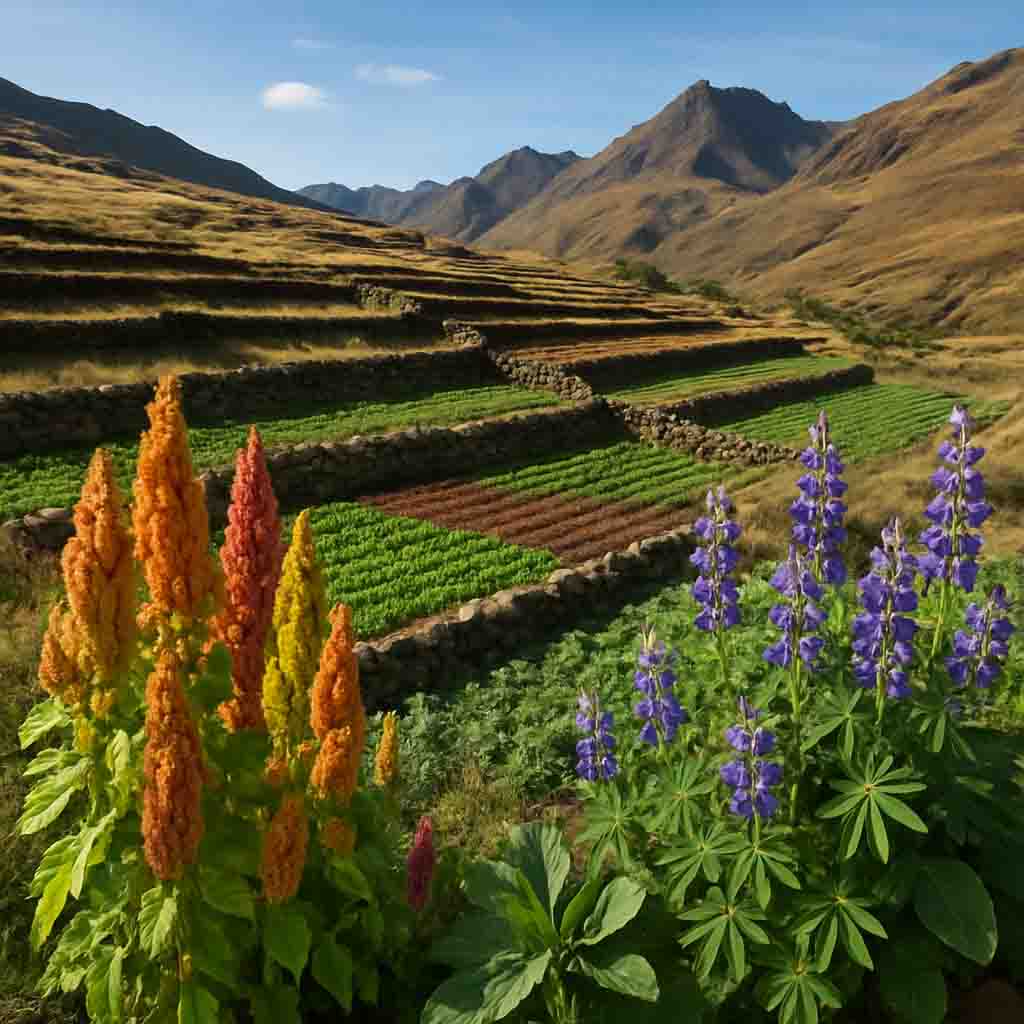
When purchasing Andean superfoods, quality indicators help ensure you receive the most nutritional benefit:
Visual and Sensory Cues
Physical characteristics can indicate quality and freshness:
- Color vibrancy: Bright, consistent coloration suggests proper handling
- Aroma: Fresh, clean scent without mustiness or rancidity
- Texture consistency: Uniform grain size and texture indicate proper processing
- Cleanliness: Minimal dust, foreign material, or broken grains
- Moisture level: Properly dried products without excessive dryness or moisture
Certifications and Standards
Look for meaningful certifications that verify quality and ethics:
- Organic certification: Verifies production without synthetic pesticides
- Fair trade certification: Ensures ethical labor practices and fair compensation
- Non-GMO verification: Confirms no genetic modification (although most Andean crops are not commonly GMO)
- Gluten-free certification: Important for those with celiac disease or gluten sensitivity
- Country of origin labeling: Confirms authentic Andean sourcing
Packaging Considerations
How products are packaged affects both quality and sustainability:
- Light protection: Opaque packaging protects nutrients from degradation
- Moisture barriers: Prevents humidity from affecting quality
- Sustainable materials: Recyclable, compostable, or minimal packaging
- Proper labeling: Clear information on contents, sourcing, and expiration
- Resealable options: Maintains freshness after opening
Find more detailed guidance in our Andean Superfood Pantry: Complete Setup Guide
Recipes and Practical Applications
Beginner-Friendly Recipes
Starting your Andean superfood journey is easy with these approachable recipes:
Everyday Quinoa Base
This versatile preparation creates a foundation for countless meals
Serves 4 | Preparation time: 5 minutes | Cooking time: 20 minutes
Ingredients:
- 1 cup quinoa (any variety)
- 2 cups water or broth
- 1/4 teaspoon salt
- 1 tablespoon olive oil or butter (optional)
Preparation:
- Rinse quinoa thoroughly in a fine-mesh strainer until water runs clear.
- Combine quinoa, water, salt, and oil in a medium saucepan.
- Bring to a boil, then reduce heat to low and cover.
- Simmer for 15 minutes until liquid is absorbed.
- Remove from heat and let stand, covered, for 5 minutes.
- Fluff with a fork before serving.
Serving variations:
- Breakfast: Top with milk, fruit, and honey
- Lunch: Add roasted vegetables, herbs, and protein
- Dinner: Use as a side dish with herbs and lemon
- Meal prep: Refrigerate in portions for quick meals throughout the week
Find more simple preparations in our 7-Day Andean Superfood Meal Plan
Basic Superfood Smoothie
A simple template for incorporating superfood powders
Serves 1 | Preparation time: 5 minutes
Ingredients:
- 1 cup liquid base (milk, plant milk, or water)
- 1 cup fruit (banana, berries, mango)
- 1-2 teaspoons Andean superfood powder (maca, lucuma, or camu camu)
- 1 tablespoon healthy fat (nut butter, avocado, or yogurt)
- Ice cubes (optional)
- Sweetener to taste (optional)
Preparation:
- Combine all ingredients in a blender.
- Blend until smooth.
- Adjust thickness with additional liquid if needed.
- Taste and adjust sweetness if desired.
Superfood variations:
- Energy boost: Use maca powder with banana and almond butter
- Immune support: Use camu camu with berries and yogurt
- Natural sweetness: Use lucuma with mango and coconut milk
Discover more superfood combinations in Andean Superfoods for Specific Health Goals
Advanced Culinary Applications
As you become comfortable with basic preparations, explore these more complex applications:
Fermented Quinoa and Amaranth Bread
A naturally leavened bread using Andean grains
Makes 1 loaf | Preparation time: 30 minutes (plus fermentation time) | Baking time: 40 minutes
Ingredients:
- 1 cup quinoa, soaked overnight and drained
- 1/2 cup amaranth, soaked overnight and drained
- 1 cup active sourdough starter
- 1 1/2 cups whole grain flour
- 1 1/2 teaspoons salt
- 1 tablespoon honey or yacón syrup
- 1 1/4 cups water
- 2 tablespoons olive oil
- Optional additions: seeds, nuts, dried fruit
Preparation:
- Blend soaked quinoa and amaranth with 1/2 cup water until smooth.
- In a large bowl, combine grain puree with sourdough starter, flour, salt, sweetener, remaining water, and oil.
- Mix until a sticky dough forms, then cover and let ferment at room temperature for 4-6 hours.
- Fold in any optional additions, then transfer to an oiled loaf pan.
- Allow to rise for 1-2 hours until visibly increased in volume.
- Preheat oven to 375°F (190°C).
- Bake for 40 minutes until golden and internal temperature reaches 205°F (96°C).
- Cool completely before slicing.
For more advanced fermentation techniques, see our Advanced Andean Cooking Techniques guide
Andean Superfoods for Family Meals
Introducing Andean superfoods to family meals can expand children’s palates while boosting nutrition:
Kid-Friendly Quinoa Pizza Bites
Nutritious finger food the whole family will enjoy
Makes approximately 24 bites | Preparation time: 15 minutes | Cooking time: 25 minutes
Ingredients:
- 2 cups cooked and cooled quinoa
- 3 large eggs, lightly beaten
- 1 cup grated mozzarella cheese
- 1/2 cup grated parmesan cheese
- 1/2 cup finely chopped bell pepper
- 1/4 cup finely chopped fresh basil or 1 tablespoon dried Italian herbs
- 1/4 cup tomato paste
- 1 teaspoon garlic powder
- 1/2 teaspoon salt
- Pizza sauce for dipping
Preparation:
- Preheat oven to 350°F (175°C).
- Combine all ingredients except pizza sauce in a large bowl and mix well.
- Grease mini muffin tins thoroughly.
- Spoon mixture into tins, filling each cup completely.
- Press down gently to compact.
- Bake for 20-25 minutes until edges are crispy and golden.
- Allow to cool for 5 minutes before removing from tins.
- Serve warm with pizza sauce for dipping.
Discover more family-friendly recipes in our guide to Andean Superfoods for Families
Conclusion: Your Andean Superfood Journey Begins
Embracing Andean Superfoods as Part of a Balanced Lifestyle
The remarkable foods of the Andes represent more than just trendy ingredients or nutritional supplements—they offer a window into sustainable food systems that have nourished civilizations for millennia. By incorporating these foods into your kitchen, you connect with traditions that harmonize human health with environmental stewardship.
The true power of Andean superfoods lies not in consuming any single ingredient but in embracing the diversity and wisdom of this ancient food system:
- Biodiversity: Valuing the array of varieties and species that create resilient food networks
- Traditional wisdom: Honoring preparation methods that maximize nutritional benefits
- Seasonal rhythms: Aligning consumption with natural cycles and seasonal availability
- Community connections: Supporting the farmers and cultures that maintain these traditions
- Balanced approach: Integrating these foods as part of a varied and joyful diet
Gradual Integration: Your Next Steps
The journey into Andean superfoods doesn’t require an overnight transformation of your diet. Consider these approachable next steps:
- Start with one: Choose a single Andean superfood that interests you most and experiment with simple preparations
- Weekly exploration: Designate one meal each week to feature a new Andean ingredient
- Pantry transformation: Gradually replace conventional items with nutritious Andean alternatives
- Seasonal engagement: Align your exploration with seasonal availability and traditional cycles
- Community connection: Share your discoveries with friends and family, spreading the benefits of these remarkable foods
Take Action Today
We encourage you to begin your Andean superfood journey with one simple step:
- Choose your starting point: Select either quinoa, maca, or amaranth as your first exploration
- Purchase with purpose: Find a sustainably sourced, high-quality version of your chosen superfood
- Try a simple recipe: Begin with one of our beginner-friendly recipes in this guide
- Document your experience: Note how you feel after incorporating these foods regularly
- Share your journey: Connect with our community by sharing your experiences and questions
Whether you’re seeking improved nutrition, exploring cultural food traditions, or simply expanding your culinary horizons, Andean superfoods offer a remarkable path forward. We invite you to discover these treasures for yourself and experience their transformative potential.
Ready to begin? Start building your Andean pantry with our Andean Superfood Pantry: Complete Setup Guide
Related Resources
Supporting Content for Further Learning
Explore these in-depth resources to deepen your understanding of specific aspects of Andean superfoods:
Superfood Deep Dives
- Quinoa: Complete Guide to the Mother Grain
- Maca Root: Ancient Energizer for Modern Life
- Amaranth: The Forgotten Protein Powerhouse
- Cooking with Andean Tubers: Beyond Potatoes
Practical Applications
- 7-Day Andean Superfood Meal Plan
- Andean Superfoods for Specific Health Goals
- Andean Superfood Pantry: Complete Setup Guide
- Andean Superfood Substitution Guide
- Troubleshooting Guide: Common Mistakes with Andean Superfoods
Specialized Interest Resources
- Andean Superfoods for Plant-Based Athletes
- Andean Superfoods for Families
- Advanced Andean Cooking Techniques
Cultural and Environmental Context
- Sacred Foods: The Spiritual Significance of Andean Superfoods
- From Field to Table: The Journey of Andean Superfoods
- Seasonal Guide to Andean Superfoods
- The Andean Cooking Method: A Complete Guide
Books and Additional Resources
For those seeking deeper understanding beyond our website:
- Books: Recommended titles on Andean cuisine, nutrition, and cultural traditions
- Academic Research: Selected studies on the nutritional benefits of Andean foods
- Community Resources: Organizations supporting Andean agricultural traditions
- Sustainability Initiatives: Projects working to preserve Andean crop diversity
This guide was last updated in January 2025. Nutritional information and availability may vary by region and season. Always consult with a healthcare professional before making significant dietary changes, particularly if you have existing health conditions.
